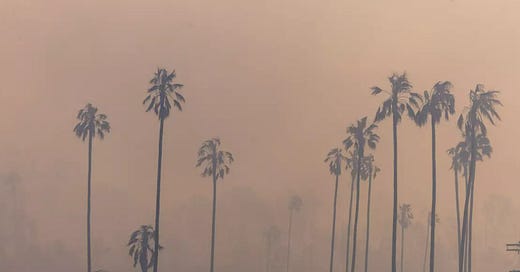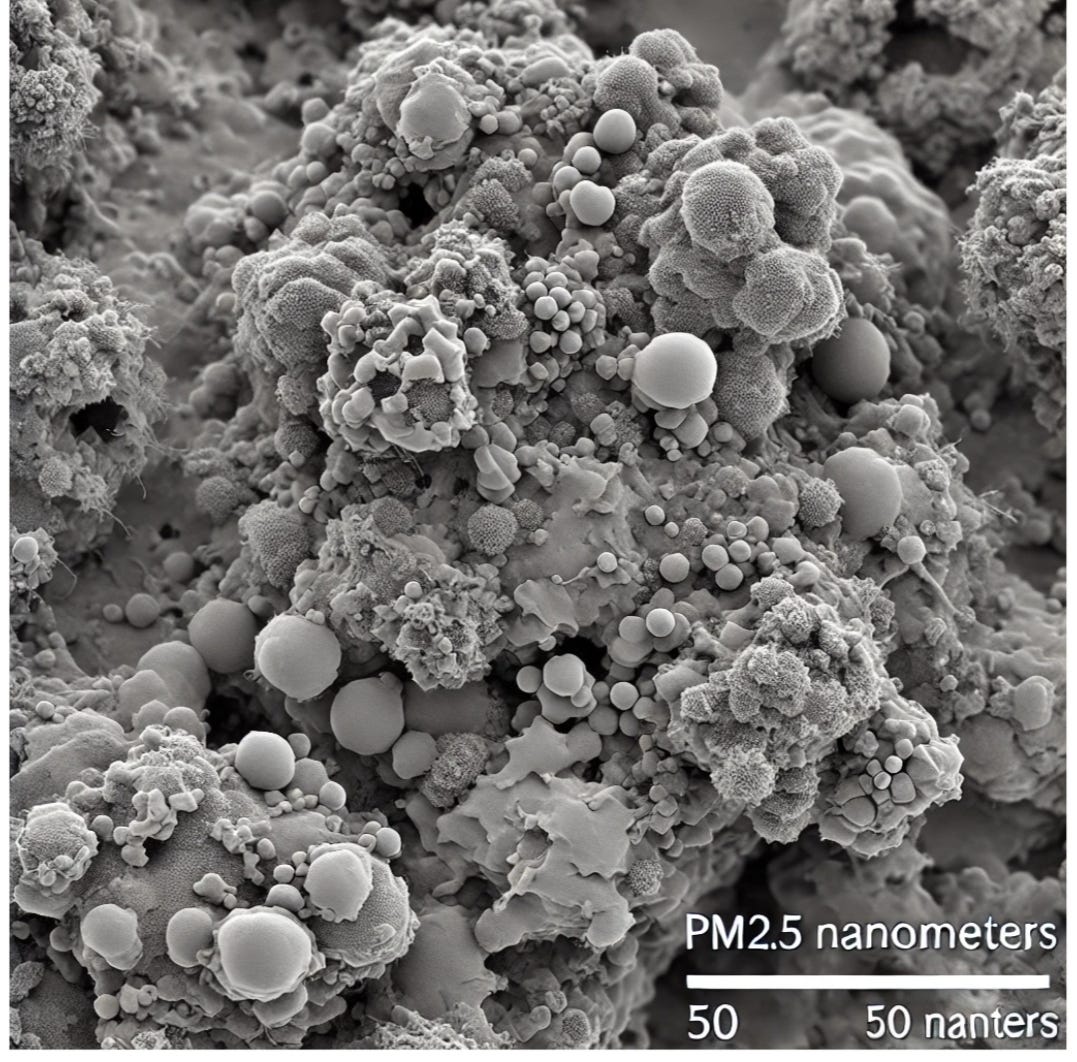Toxic Particulate Matter from the Los Angeles County, California Wildfires
Impact and Analysis
Contributing Author: Robert O. Young, CPT, MSc, DSc, PhD, ND - Naturopathic Practitioner
Wildfires are an increasingly severe environmental and public health crisis. These fires release large quantities of particulate matter (PM), including PM2.5, and other toxic pollutants into the atmosphere, creating hazardous air quality conditions. PM2.5 is particularly concerning because its microscopic size allows it to penetrate deep into the respiratory system and enter the bloodstream, posing significant risks systemically to vulnerable populations and particularly to cardiovascular and respiratory health.
In recent years, wildfire activity in areas such as Sherman Oaks, Encino, and Santa Monica has resulted in alarming PM2.5 concentrations, often exceeding safe limits set by the World Health Organization (WHO) and the U.S. Environmental Protection Agency (EPA). This article investigates PM2.5 concentrations in these areas and others, providing a comprehensive analysis of the health and environmental impacts of wildfire pollution. By examining current data and mitigation strategies, the below study aims to highlight the urgent need for effective solutions to protect public health and enhance air quality.
We will systematically evaluate PM2.5 levels across heavily impacted areas, including Sherman Oaks, Encino, Studio City, Universal City, Los Angeles, Santa Monica, Calabasas, Santa Barbara, Pacific Palisades, Woodland Hills, Beverly Hills, Pasadena, Malibu, and Alta Dena.
Using real-time air quality data, field observations, and epidemiological analysis, this research provides actionable insights into the scale of wildfire pollution, its health implications, and potential mitigation strategies. Innovative solutions, such as the use of MasterPeace Zeolite Z® for detoxification, alongside policy and public health interventions, are proposed to mitigate the adverse effects of wildfire pollution on public health and the environment.
Methodology
This study utilized a multi-pronged approach to assess the impacts of wildfire-related PM2.5 pollution:
Data Collection:
Real-time air quality data were sourced from IQAir and the U.S. Environmental Protection Agency (EPA). These platforms provided hourly PM2.5 concentrations for the identified locations, including Sherman Oaks, Pasadena, and Santa Monica.
Historical data were reviewed to assess trends in air quality over the past decade in wildfire-prone areas.
Analysis Framework:
PM2.5 levels were compared against WHO’s annual and 24-hour limits (5 µg/m³ and 15 µg/m³, respectively) to determine exceedance rates.
Health risk assessments were conducted using established epidemiological models linking PM2.5 exposure to respiratory and cardiovascular outcomes.
Field Observations:
Observations of air quality and visibility during active wildfire events were integrated to provide contextual insights into pollution severity.
Interviews with local residents and health professionals were conducted to gather qualitative data on health impacts.
Types of Particulate Matter from Wildfires
PM2.5 (Fine Particulate Matter):
Size: Particles smaller than 2.5 micrometers in diameter.
Sources: Combustion of organic materials, including vegetation and structures [1].
Health Impact: Respiratory and cardiovascular health complications [2].
PM10 (Coarse Particulate Matter):
Size: Particles between 2.5 and 10 micrometers in diameter.
Sources: Ash, soil, and debris stirred by fire or wind [1].
Volatile Organic Compounds (VOCs) and Other Pollutants:
Includes benzene, carbon monoxide, nitrogen oxides, heavy metals, and polycyclic aromatic hydrocarbons (PAHs) [4][5][8].
Chemical Pollutants Identified
Benzene: A known carcinogen released during combustion [4].
Formaldehyde: Toxic gas contributing to respiratory issues [7].
Carbon Monoxide (CO): Impairs oxygen delivery to the body [5].
Nitrogen Oxides (NOx): Contribute to ozone and secondary pollutant formation [6].
Heavy Metals: Including lead, mercury, and cadmium, released from burning structures [7].
Polycyclic Aromatic Hydrocarbons (PAHs): Carcinogenic compounds formed during incomplete combustion [8].
PM2.5 Concentrations in Wildfire-Affected Areas
Sherman Oaks: PM2.5 ≈19 µg/m³ (Moderate) [9].
Santa Monica: PM2.5 ≈132 µg/m³ (Unhealthy for Sensitive Groups) [9].
Pacific Palisades: PM2.5 ≈69 µg/m³ (Unhealthy for Sensitive Groups) [9].
Pasadena: PM2.5 ≈45 µg/m³ (Moderate) [9].
Malibu: PM2.5 ≈55 µg/m³ (Moderate) [9].
Alta Dena: PM2.5 ≈45 µg/m³ (Moderate) [9].
Encino: PM2.5 ≈35 µg/m³ (Moderate) [9].
Other Areas: Moderate to Unhealthy levels reported in Universal City, Calabasas, and Beverly Hills [9].
Transmission Electron Micrograph (HRTEM) of the PM 2.5
[Figure 1: High-Resolution Transmission Electron Micrograph (HRTEM) of fine particulate matter (PM2.5) sampled from the Los Angeles, California area, a region currently impacted by significant wildfire activity. The micrograph captures nanoscale particles with diverse and irregular morphologies, showcasing variations in size, shape, and texture - Copyright 2025 - Hikari Omni Media and Robert O, Young]
Key observations include:
Crystalline Structures: Some particles display lattice fringes and sharp edges, indicative of crystalline forms, likely originating from combustion processes [1][3][4].
Amorphous Particles: Other particles exhibit smooth, undefined boundaries, representing amorphous materials typical of organic compounds or soot [5].
Aggregation: Evidence of particle agglomeration is apparent, with smaller particles coalescing into larger clusters, a characteristic often observed in airborne pollutants [6].
The 50-nanometer scale bar provides spatial context, highlighting the ultrafine dimensions of PM2.5 particles. These particles are known to penetrate deep into the respiratory system, emphasizing their relevance in air quality studies and health risk assessments [7].
This micrograph serves as a valuable visualization for understanding the complex morphology of PM2.5 in wildfire-affected areas and underscores the importance of studying air pollution's structural and compositional diversity. Let me know if further details are required! [8].
Health Implications
Chronic exposure to PM2.5 (annual limit: 5 µg/m³) increases risks of chronic bronchitis and reduced lung function [2].
Acute exposure (24-hour limit: 15 µg/m³) can exacerbate asthma and cause respiratory distress in sensitive populations [3].
Solutions
Personal Protection: Use N95 or P100 masks to reduce exposure to fine particulate matter [10].
Indoor Air Quality: Deploy HEPA air purifiers to mitigate indoor pollution [11].
Public Alerts: Implement real-time air quality monitoring systems to inform and guide the public during wildfire events [12].
Policy Recommendations: Strengthen wildfire prevention strategies and enforce stricter emission controls on anthropogenic activities contributing to wildfire intensity [6].
MasterPeace Zeolite Z®: A highly effective detoxifying agent designed to bind and remove heavy metals, toxins, and other harmful pollutants from the body, aiding in mitigating the effects of prolonged exposure to wildfire pollutants [13].
We can see that the widespread wildfires in Los Angeles County and surrounding regions have significantly impacted air quality, with PM2.5 levels reaching hazardous levels in multiple locations. These conditions underscore the urgent need for immediate and long-term interventions to protect public health. Coordinated efforts between policymakers, scientists, and communities are essential to address the root causes of wildfires and enhance resilience to future events.
References
U.S. Environmental Protection Agency (EPA). (2025). Particulate Matter (PM) Pollution Overview. Retrieved from https://www.epa.gov/pm-pollution. This source provides foundational information about PM pollution, including its sources, health effects, and regulatory standards.
World Health Organization (WHO). (2021). Global Air Quality Guidelines. Retrieved from
. This document outlines global standards for safe air quality levels and health impacts of PM2.5.
National Institutes of Health (NIH). (2023). Health Effects of Airborne Particulates. Retrieved from
. This source examines the biological mechanisms through which PM2.5 affects respiratory and cardiovascular health.
California Air Resources Board (CARB). (2025). Wildfire Smoke and Health. Retrieved from
. This resource details the chemical composition of wildfire smoke and its public health implications.
American Lung Association. (2025). Air Pollution and Your Health. Retrieved from
. This publication provides insights into the respiratory risks posed by PM2.5 and other pollutants.
Centers for Disease Control and Prevention (CDC). (2025). Air Pollution Facts. Retrieved from
. This guide highlights the acute and chronic health impacts of air pollution.
Environmental Defense Fund (EDF). (2025). Toxic Emissions from Wildfires. Retrieved from
. This analysis focuses on the toxic substances released during wildfires and their environmental effects.
International Agency for Research on Cancer (IARC). (2020). Polycyclic Aromatic Hydrocarbons and Cancer Risk. Retrieved from
. This report discusses the carcinogenic risks associated with PAHs in wildfire smoke.
IQAir. (2025). Real-Time Air Quality Index (AQI) Updates. Retrieved from
. This platform provides live updates on air quality, including PM2.5 levels, for affected regions.
Occupational Safety and Health Administration (OSHA). (2025). Respiratory Protection Standards. Retrieved from
. This document outlines guidelines for personal protective equipment to reduce exposure to airborne particulates.
Consumer Reports. (2025). Best Air Purifiers for Wildfire Smoke. Retrieved from
https://www.consumerreports.org
. This resource evaluates effective air purifiers for mitigating indoor air pollution.
U.S. Environmental Protection Agency (EPA). (2025). AirNow Monitoring Data. Retrieved from
. This site provides real-time data on air quality and pollutant concentrations.
Alkaline Care. (2025). MasterPeace Zeolite Z® Product Overview. Retrieved from
. This source details the detoxification properties of MasterPeace Zeolite Z® and its applications for reducing toxin exposure.





